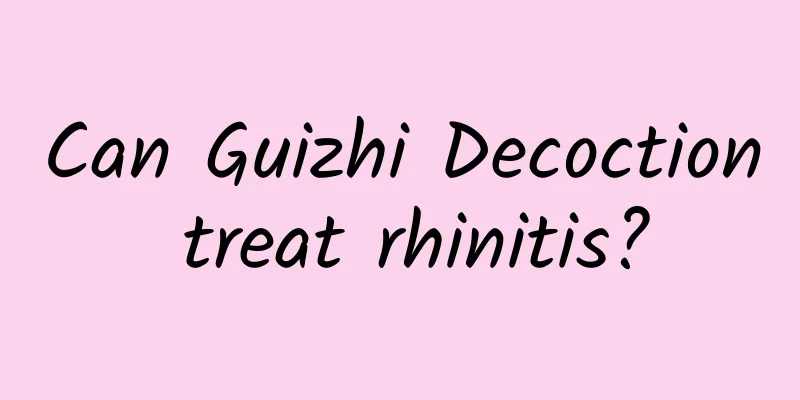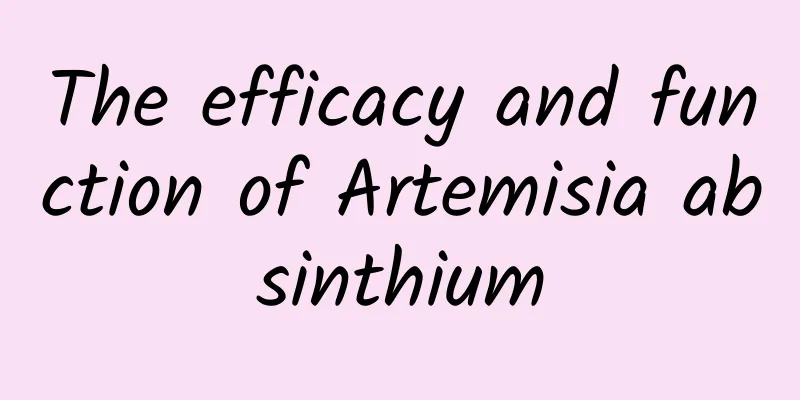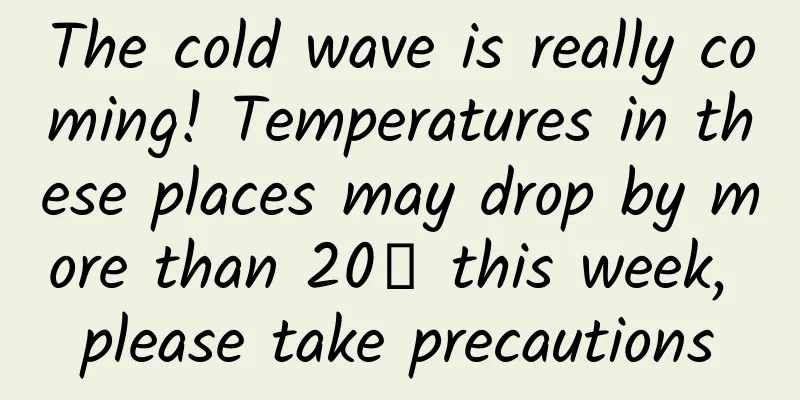Can Guizhi Decoction treat rhinitis?

|
Spring is here and everything comes to life. But at the same time, a disease has quietly made a comeback. It is allergic rhinitis. Spring and autumn are the peak seasons for allergic rhinitis. Once the disease occurs, it seriously affects life and health, which is very serious. Symptoms such as sneezing, runny nose, nasal congestion, and red and swollen eyes may also occur. Some people are even unable to work and live normally due to serious illness. So is there any way to treat and relieve allergic rhinitis? This prescription works well for allergic rhinitis! The arrival of spring makes many friends with allergies happy, but also a little worried. For example, they may encounter allergic rhinitis unexpectedly. 1. Guizhi Decoction for the treatment of rhinitis Allergic rhinitis is a common clinical disease, which belongs to the categories of "allergic rhinitis" and "nasal spray" in traditional Chinese medicine. The cause of the disease is mostly due to weak lung qi, loose pores, disharmony between the Ying and Wei, and a weak Wei surface, which allows wind and cold to enter the body, preventing the lung qi from circulating, resulting in poor orifices and symptoms such as sneezing, clear nasal discharge, and itchy nose. Therefore, Guizhi Decoction is used with modifications to harmonize the Ying and Wei systems and regulate Yin and Yang. Western medicine diagnosis: allergic rhinitis TCM diagnosis: Lung Qi is deficient and cold, and the Wei surface is not solid. Treatment method: Invigorate Qi, consolidate the exterior, and dispel wind and cold. Prescription: Guizhi Decoction combined with Yupingfeng Powder and Cangli Powder with modifications. Prescription: 6g of cinnamon twig, 6g of white peony root, 15g of astragalus, 10g of atractylodes, 6g of saposhnikovia divaricata, 6g of angelica dahurica, 6g of Xanthium sibiricum, 3g of Cimicifuga heracleifolia, 6g of ginger, 6g of ebony root, and 6g of magnolia. Chinese medicine formula granules, 6 doses, 1 dose per day, taken in 2 times. After taking one dose of medicine, symptoms such as nasal congestion and runny nose were greatly improved, and sweating was less than before. After taking the above medicine for 6 consecutive times, the symptoms of runny nose and nasal congestion disappeared. 2. Guizhi Decoction Guizhi Decoction is the name of a Chinese medicine prescription. It is an antipyretic agent with the effects of relieving exterior syndrome with pungent and warm properties, relieving muscles and releasing exterior syndrome, and harmonizing the Ying and Wei systems. It is mainly used to treat headache and fever, sweating, aversion to wind, nasal congestion and dry retching, white tongue coating without thirst, and floating and slow or weak pulse. It is commonly used clinically to treat colds, influenza, unexplained low fever, low fever after childbirth or illness, vomiting during pregnancy, erythema multiforme, frostbite, urticaria, etc., which are caused by the disharmony between the Ying and Wei systems. usage Chew the above five ingredients, add seven liters of water, boil over low heat until three liters are left, remove the dregs, and take one liter when the temperature is appropriate. Soon after taking the medicine, sip more than one liter of hot porridge to help the medicine work. Cover with warm cloth for about an hour. If you feel a slight sweat all over your body, that is better. Do not let the sweat flow like water, otherwise the disease will not be cured. If the patient sweats after taking the medicine once and the disease is cured, you can stop taking the medicine and do not have to finish the dose. If you do not sweat, take the medicine again according to the previous method. If you still do not sweat, take the medicine again with a shorter interval between doses, and finish the dose three times in about half a day. If the patient is seriously ill, take it for one day and one night, and observe the condition every week. If the symptoms persist after taking one dose, take another dose. If no sweating occurs, take up to two or three doses. Avoid eating raw, cold, sticky, meat, noodles, five pungent foods, wine, cheese, and smelly foods. (Modern usage: decoct in water and drink warm to induce slight sweating). Taboo Patients with exogenous febrile diseases, yin deficiency and hyperactivity of fire, and blood heat should avoid taking the medicine. Pregnant women and those with heavy menstruation should use it with caution. 3. Allergic rhinitis Allergic rhinitis refers to a non-infectious inflammatory disease of the nasal mucosa that occurs when an atopic individual is exposed to allergens, mainly mediated by IgE (mainly histamine) and involves the release of mediators. It also involves a variety of immune active cells and cytokines. There are three necessary conditions for its occurrence: specific antigens, which are substances that cause the body's immune response; atopic individuals, which are so-called individual differences and allergic constitutions; and the encounter between specific antigens and atopic individuals. Allergic rhinitis is a global health problem that can lead to numerous morbidities and loss of productivity. Clinical manifestations The typical symptoms of allergic rhinitis are mainly paroxysmal sneezing, clear watery nasal discharge, nasal congestion and nasal itching. Some are accompanied by decreased sense of smell. 1. Sneezing There are several paroxysmal attacks a day, more than 3 each time, mostly in the morning or at night or immediately after contact with allergens. 2. Clear nasal discharge A large amount of clear watery nasal discharge may sometimes drip from the nostrils unconsciously. 3. Nasal congestion Intermittent or continuous, unilateral or bilateral, with varying degrees of severity. 4. Itchy nose Most patients experience itching in the nose, while those with hay fever may also experience itching in the eyes, ears, and throat. |
<<: Is mugwort useful for rhinitis?
>>: Is it effective to drink the resurrection grass soaked in water?
Recommend
Nature: AI is so useful that it makes people too arrogant
In recent years, the application and impact of ar...
The efficacy and function of Clematis chinensis leaves
Clematis chinensis leaves are a frequently used m...
The taller you are, the higher your risk of getting these 3 diseases!
A person's height is determined by a combinat...
Can Jiaogulan and Lingzhi be soaked in water and drunk at the same time?
In our lives, there are always many common nouris...
Distraction: The unexpected benefits
© Behance Leviathan Press: Mind-wandering, also k...
Yishen Xingyang Capsule
In daily life, many people have to stay in the of...
The efficacy and function of yak horn
Many people are not very clear about the efficacy...
Let’s be honest: if you slack off while working, you will be more tired!
Have you ever had such an experience of "sla...
Asteroids, micrometeors, fireballs...how do we distinguish between similar "stars"?
According to the solar nebula theory, the solar s...
In the history of chemistry, there are 3 diamonds that make people laugh and cry
Diamond is the hardest substance known in nature....
The efficacy and function of Oriental pod fern
Oriental pod fern is a common type of traditional...
What are the functions and effects of Angelica dahurica
Angelica dahurica is a traditional Chinese medici...
Exclusive interview with Li Lanjuan: Can humans eventually defeat the new coronavirus? Technology is the key to fighting the epidemic
The epidemic is really affecting our lives. In th...
The efficacy and function of the root bark of Myrica pubescens
Do you know what the root bark of Myrica pubescen...
The efficacy and function of rabbit meat
Many people are not very clear about rabbit meat,...









